Analyzing Community-Based Education in Health Professions
VerifiedAdded on 2023/04/20
|12
|3254
|341
Case Study
AI Summary
This case study provides an analysis of Community-Based Education (CBE) programs, comparing their application in Bangladesh and India. It defines CBE as a learning approach that integrates learners with community settings to foster professional competencies and address local needs. The analysis covers the nature of the CBE programs in both countries, highlighting the involvement of schools, hospitals, communities, and governments as key partners. It examines the community settings where students interact with local populations, the duration of the programs, and the methods of student assessment, emphasizing the blend of classroom learning and practical community engagement. The study underscores the importance of these programs in developing well-rounded healthcare professionals who are responsive to community health needs. Desklib offers a platform for students to access similar solved assignments and past papers for comprehensive study support.
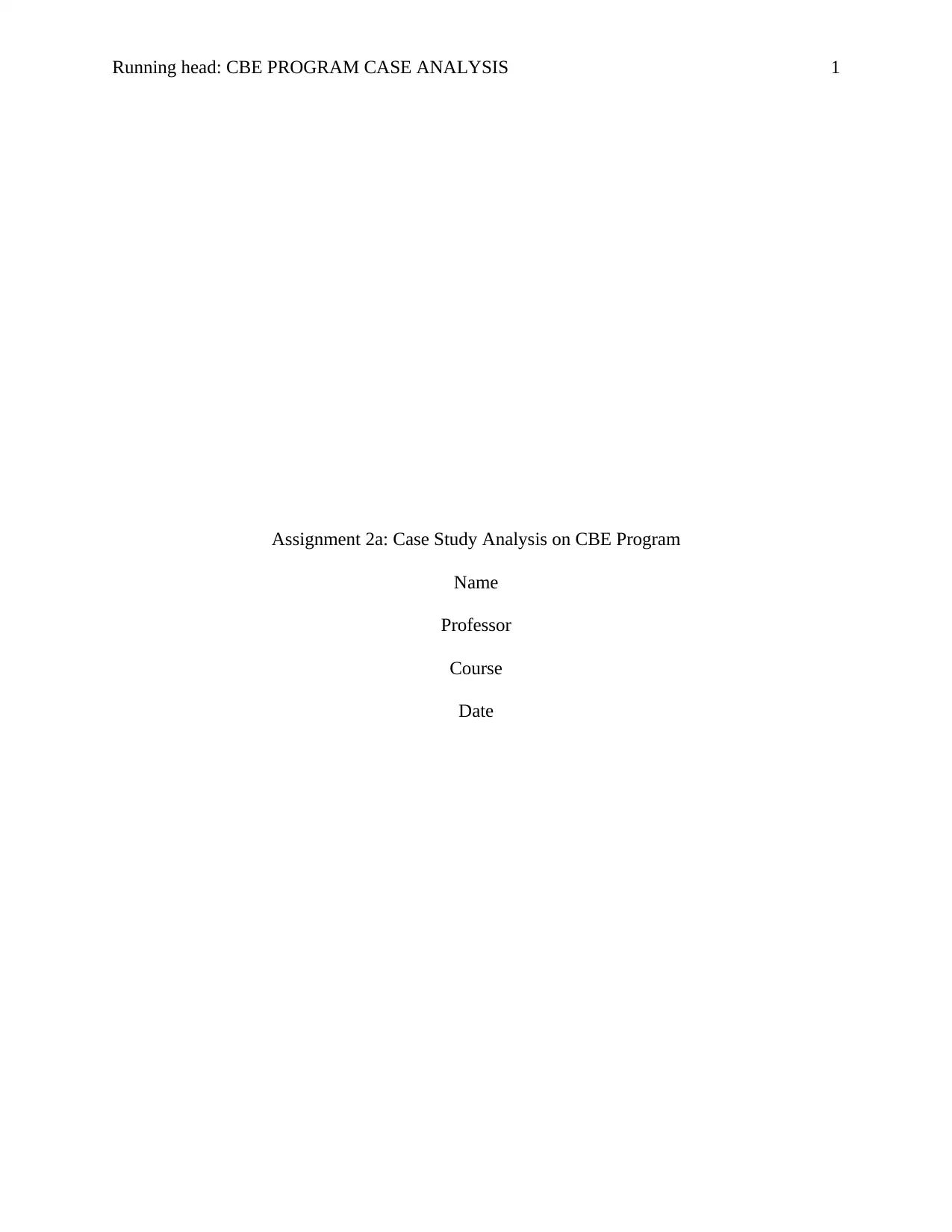
Running head: CBE PROGRAM CASE ANALYSIS 1
Assignment 2a: Case Study Analysis on CBE Program
Name
Professor
Course
Date
Assignment 2a: Case Study Analysis on CBE Program
Name
Professor
Course
Date
Paraphrase This Document
Need a fresh take? Get an instant paraphrase of this document with our AI Paraphraser
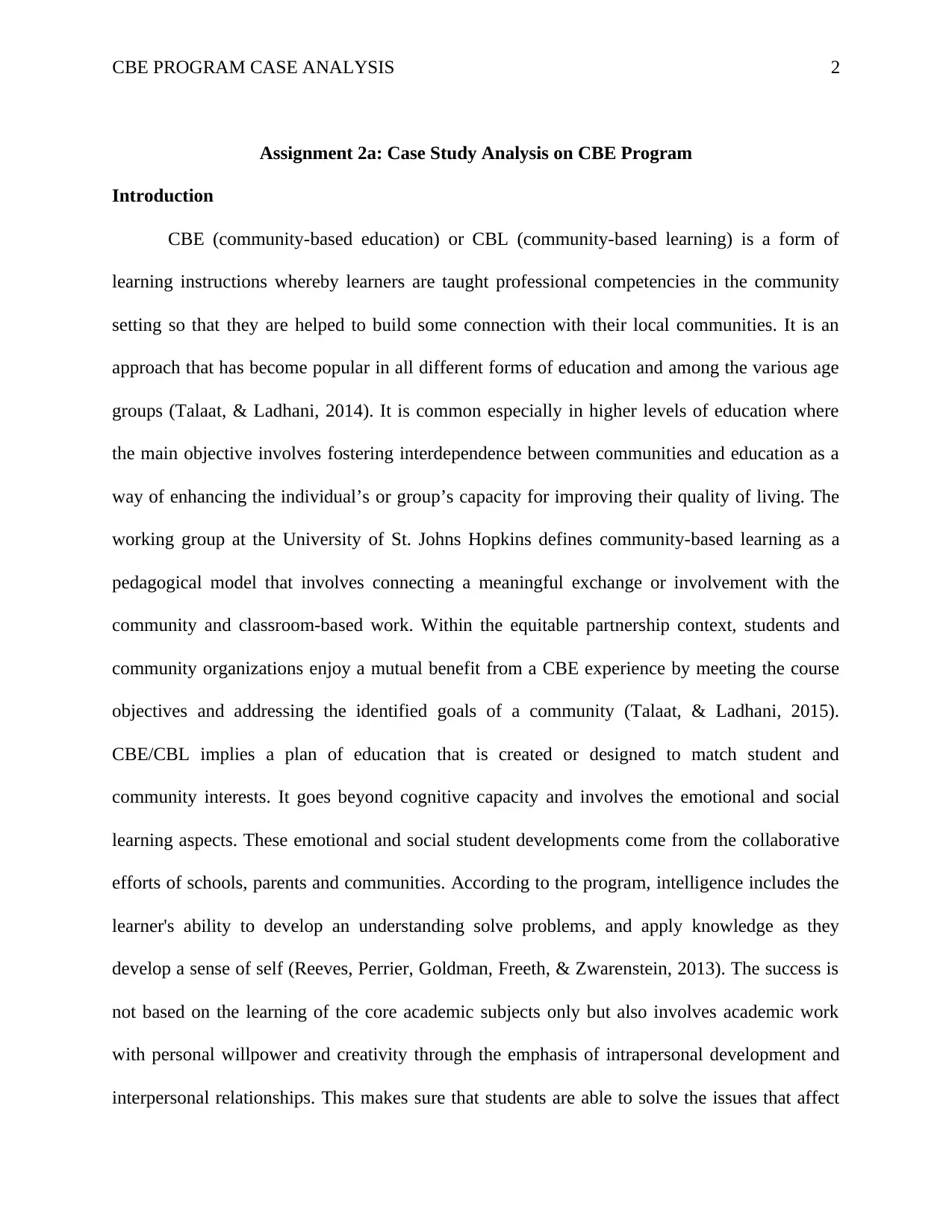
CBE PROGRAM CASE ANALYSIS 2
Assignment 2a: Case Study Analysis on CBE Program
Introduction
CBE (community-based education) or CBL (community-based learning) is a form of
learning instructions whereby learners are taught professional competencies in the community
setting so that they are helped to build some connection with their local communities. It is an
approach that has become popular in all different forms of education and among the various age
groups (Talaat, & Ladhani, 2014). It is common especially in higher levels of education where
the main objective involves fostering interdependence between communities and education as a
way of enhancing the individual’s or group’s capacity for improving their quality of living. The
working group at the University of St. Johns Hopkins defines community-based learning as a
pedagogical model that involves connecting a meaningful exchange or involvement with the
community and classroom-based work. Within the equitable partnership context, students and
community organizations enjoy a mutual benefit from a CBE experience by meeting the course
objectives and addressing the identified goals of a community (Talaat, & Ladhani, 2015).
CBE/CBL implies a plan of education that is created or designed to match student and
community interests. It goes beyond cognitive capacity and involves the emotional and social
learning aspects. These emotional and social student developments come from the collaborative
efforts of schools, parents and communities. According to the program, intelligence includes the
learner's ability to develop an understanding solve problems, and apply knowledge as they
develop a sense of self (Reeves, Perrier, Goldman, Freeth, & Zwarenstein, 2013). The success is
not based on the learning of the core academic subjects only but also involves academic work
with personal willpower and creativity through the emphasis of intrapersonal development and
interpersonal relationships. This makes sure that students are able to solve the issues that affect
Assignment 2a: Case Study Analysis on CBE Program
Introduction
CBE (community-based education) or CBL (community-based learning) is a form of
learning instructions whereby learners are taught professional competencies in the community
setting so that they are helped to build some connection with their local communities. It is an
approach that has become popular in all different forms of education and among the various age
groups (Talaat, & Ladhani, 2014). It is common especially in higher levels of education where
the main objective involves fostering interdependence between communities and education as a
way of enhancing the individual’s or group’s capacity for improving their quality of living. The
working group at the University of St. Johns Hopkins defines community-based learning as a
pedagogical model that involves connecting a meaningful exchange or involvement with the
community and classroom-based work. Within the equitable partnership context, students and
community organizations enjoy a mutual benefit from a CBE experience by meeting the course
objectives and addressing the identified goals of a community (Talaat, & Ladhani, 2015).
CBE/CBL implies a plan of education that is created or designed to match student and
community interests. It goes beyond cognitive capacity and involves the emotional and social
learning aspects. These emotional and social student developments come from the collaborative
efforts of schools, parents and communities. According to the program, intelligence includes the
learner's ability to develop an understanding solve problems, and apply knowledge as they
develop a sense of self (Reeves, Perrier, Goldman, Freeth, & Zwarenstein, 2013). The success is
not based on the learning of the core academic subjects only but also involves academic work
with personal willpower and creativity through the emphasis of intrapersonal development and
interpersonal relationships. This makes sure that students are able to solve the issues that affect
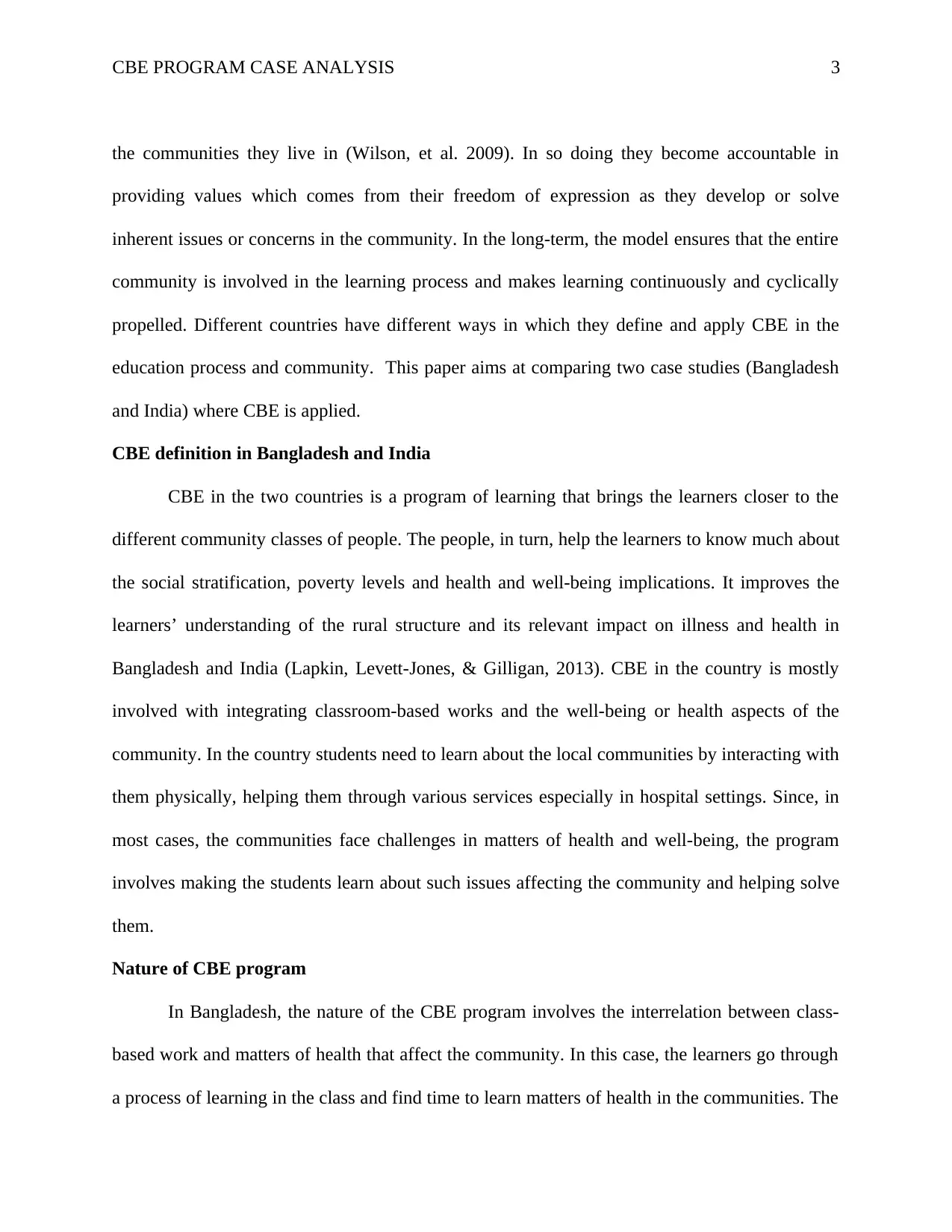
CBE PROGRAM CASE ANALYSIS 3
the communities they live in (Wilson, et al. 2009). In so doing they become accountable in
providing values which comes from their freedom of expression as they develop or solve
inherent issues or concerns in the community. In the long-term, the model ensures that the entire
community is involved in the learning process and makes learning continuously and cyclically
propelled. Different countries have different ways in which they define and apply CBE in the
education process and community. This paper aims at comparing two case studies (Bangladesh
and India) where CBE is applied.
CBE definition in Bangladesh and India
CBE in the two countries is a program of learning that brings the learners closer to the
different community classes of people. The people, in turn, help the learners to know much about
the social stratification, poverty levels and health and well-being implications. It improves the
learners’ understanding of the rural structure and its relevant impact on illness and health in
Bangladesh and India (Lapkin, Levett-Jones, & Gilligan, 2013). CBE in the country is mostly
involved with integrating classroom-based works and the well-being or health aspects of the
community. In the country students need to learn about the local communities by interacting with
them physically, helping them through various services especially in hospital settings. Since, in
most cases, the communities face challenges in matters of health and well-being, the program
involves making the students learn about such issues affecting the community and helping solve
them.
Nature of CBE program
In Bangladesh, the nature of the CBE program involves the interrelation between class-
based work and matters of health that affect the community. In this case, the learners go through
a process of learning in the class and find time to learn matters of health in the communities. The
the communities they live in (Wilson, et al. 2009). In so doing they become accountable in
providing values which comes from their freedom of expression as they develop or solve
inherent issues or concerns in the community. In the long-term, the model ensures that the entire
community is involved in the learning process and makes learning continuously and cyclically
propelled. Different countries have different ways in which they define and apply CBE in the
education process and community. This paper aims at comparing two case studies (Bangladesh
and India) where CBE is applied.
CBE definition in Bangladesh and India
CBE in the two countries is a program of learning that brings the learners closer to the
different community classes of people. The people, in turn, help the learners to know much about
the social stratification, poverty levels and health and well-being implications. It improves the
learners’ understanding of the rural structure and its relevant impact on illness and health in
Bangladesh and India (Lapkin, Levett-Jones, & Gilligan, 2013). CBE in the country is mostly
involved with integrating classroom-based works and the well-being or health aspects of the
community. In the country students need to learn about the local communities by interacting with
them physically, helping them through various services especially in hospital settings. Since, in
most cases, the communities face challenges in matters of health and well-being, the program
involves making the students learn about such issues affecting the community and helping solve
them.
Nature of CBE program
In Bangladesh, the nature of the CBE program involves the interrelation between class-
based work and matters of health that affect the community. In this case, the learners go through
a process of learning in the class and find time to learn matters of health in the communities. The
⊘ This is a preview!⊘
Do you want full access?
Subscribe today to unlock all pages.

Trusted by 1+ million students worldwide
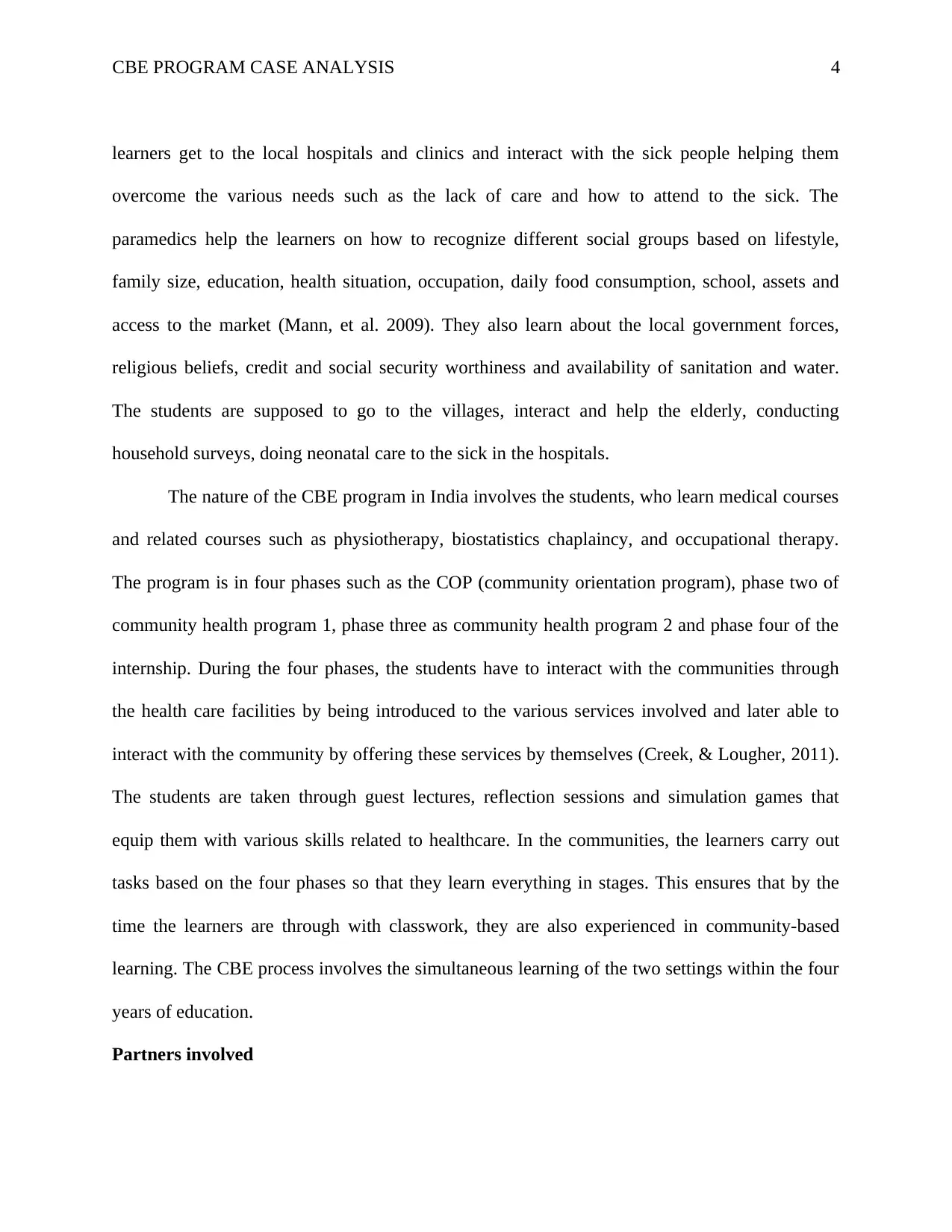
CBE PROGRAM CASE ANALYSIS 4
learners get to the local hospitals and clinics and interact with the sick people helping them
overcome the various needs such as the lack of care and how to attend to the sick. The
paramedics help the learners on how to recognize different social groups based on lifestyle,
family size, education, health situation, occupation, daily food consumption, school, assets and
access to the market (Mann, et al. 2009). They also learn about the local government forces,
religious beliefs, credit and social security worthiness and availability of sanitation and water.
The students are supposed to go to the villages, interact and help the elderly, conducting
household surveys, doing neonatal care to the sick in the hospitals.
The nature of the CBE program in India involves the students, who learn medical courses
and related courses such as physiotherapy, biostatistics chaplaincy, and occupational therapy.
The program is in four phases such as the COP (community orientation program), phase two of
community health program 1, phase three as community health program 2 and phase four of the
internship. During the four phases, the students have to interact with the communities through
the health care facilities by being introduced to the various services involved and later able to
interact with the community by offering these services by themselves (Creek, & Lougher, 2011).
The students are taken through guest lectures, reflection sessions and simulation games that
equip them with various skills related to healthcare. In the communities, the learners carry out
tasks based on the four phases so that they learn everything in stages. This ensures that by the
time the learners are through with classwork, they are also experienced in community-based
learning. The CBE process involves the simultaneous learning of the two settings within the four
years of education.
Partners involved
learners get to the local hospitals and clinics and interact with the sick people helping them
overcome the various needs such as the lack of care and how to attend to the sick. The
paramedics help the learners on how to recognize different social groups based on lifestyle,
family size, education, health situation, occupation, daily food consumption, school, assets and
access to the market (Mann, et al. 2009). They also learn about the local government forces,
religious beliefs, credit and social security worthiness and availability of sanitation and water.
The students are supposed to go to the villages, interact and help the elderly, conducting
household surveys, doing neonatal care to the sick in the hospitals.
The nature of the CBE program in India involves the students, who learn medical courses
and related courses such as physiotherapy, biostatistics chaplaincy, and occupational therapy.
The program is in four phases such as the COP (community orientation program), phase two of
community health program 1, phase three as community health program 2 and phase four of the
internship. During the four phases, the students have to interact with the communities through
the health care facilities by being introduced to the various services involved and later able to
interact with the community by offering these services by themselves (Creek, & Lougher, 2011).
The students are taken through guest lectures, reflection sessions and simulation games that
equip them with various skills related to healthcare. In the communities, the learners carry out
tasks based on the four phases so that they learn everything in stages. This ensures that by the
time the learners are through with classwork, they are also experienced in community-based
learning. The CBE process involves the simultaneous learning of the two settings within the four
years of education.
Partners involved
Paraphrase This Document
Need a fresh take? Get an instant paraphrase of this document with our AI Paraphraser
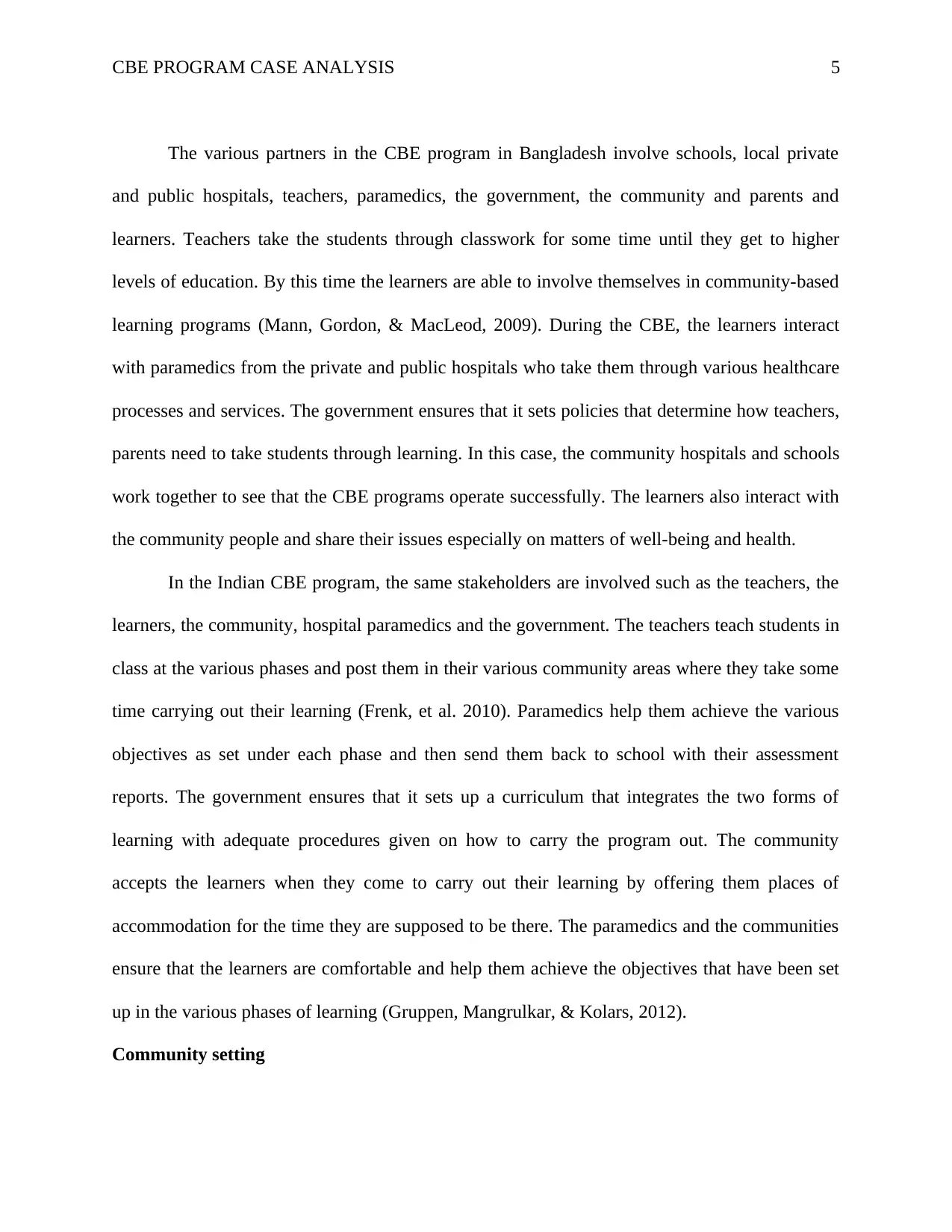
CBE PROGRAM CASE ANALYSIS 5
The various partners in the CBE program in Bangladesh involve schools, local private
and public hospitals, teachers, paramedics, the government, the community and parents and
learners. Teachers take the students through classwork for some time until they get to higher
levels of education. By this time the learners are able to involve themselves in community-based
learning programs (Mann, Gordon, & MacLeod, 2009). During the CBE, the learners interact
with paramedics from the private and public hospitals who take them through various healthcare
processes and services. The government ensures that it sets policies that determine how teachers,
parents need to take students through learning. In this case, the community hospitals and schools
work together to see that the CBE programs operate successfully. The learners also interact with
the community people and share their issues especially on matters of well-being and health.
In the Indian CBE program, the same stakeholders are involved such as the teachers, the
learners, the community, hospital paramedics and the government. The teachers teach students in
class at the various phases and post them in their various community areas where they take some
time carrying out their learning (Frenk, et al. 2010). Paramedics help them achieve the various
objectives as set under each phase and then send them back to school with their assessment
reports. The government ensures that it sets up a curriculum that integrates the two forms of
learning with adequate procedures given on how to carry the program out. The community
accepts the learners when they come to carry out their learning by offering them places of
accommodation for the time they are supposed to be there. The paramedics and the communities
ensure that the learners are comfortable and help them achieve the objectives that have been set
up in the various phases of learning (Gruppen, Mangrulkar, & Kolars, 2012).
Community setting
The various partners in the CBE program in Bangladesh involve schools, local private
and public hospitals, teachers, paramedics, the government, the community and parents and
learners. Teachers take the students through classwork for some time until they get to higher
levels of education. By this time the learners are able to involve themselves in community-based
learning programs (Mann, Gordon, & MacLeod, 2009). During the CBE, the learners interact
with paramedics from the private and public hospitals who take them through various healthcare
processes and services. The government ensures that it sets policies that determine how teachers,
parents need to take students through learning. In this case, the community hospitals and schools
work together to see that the CBE programs operate successfully. The learners also interact with
the community people and share their issues especially on matters of well-being and health.
In the Indian CBE program, the same stakeholders are involved such as the teachers, the
learners, the community, hospital paramedics and the government. The teachers teach students in
class at the various phases and post them in their various community areas where they take some
time carrying out their learning (Frenk, et al. 2010). Paramedics help them achieve the various
objectives as set under each phase and then send them back to school with their assessment
reports. The government ensures that it sets up a curriculum that integrates the two forms of
learning with adequate procedures given on how to carry the program out. The community
accepts the learners when they come to carry out their learning by offering them places of
accommodation for the time they are supposed to be there. The paramedics and the communities
ensure that the learners are comfortable and help them achieve the objectives that have been set
up in the various phases of learning (Gruppen, Mangrulkar, & Kolars, 2012).
Community setting
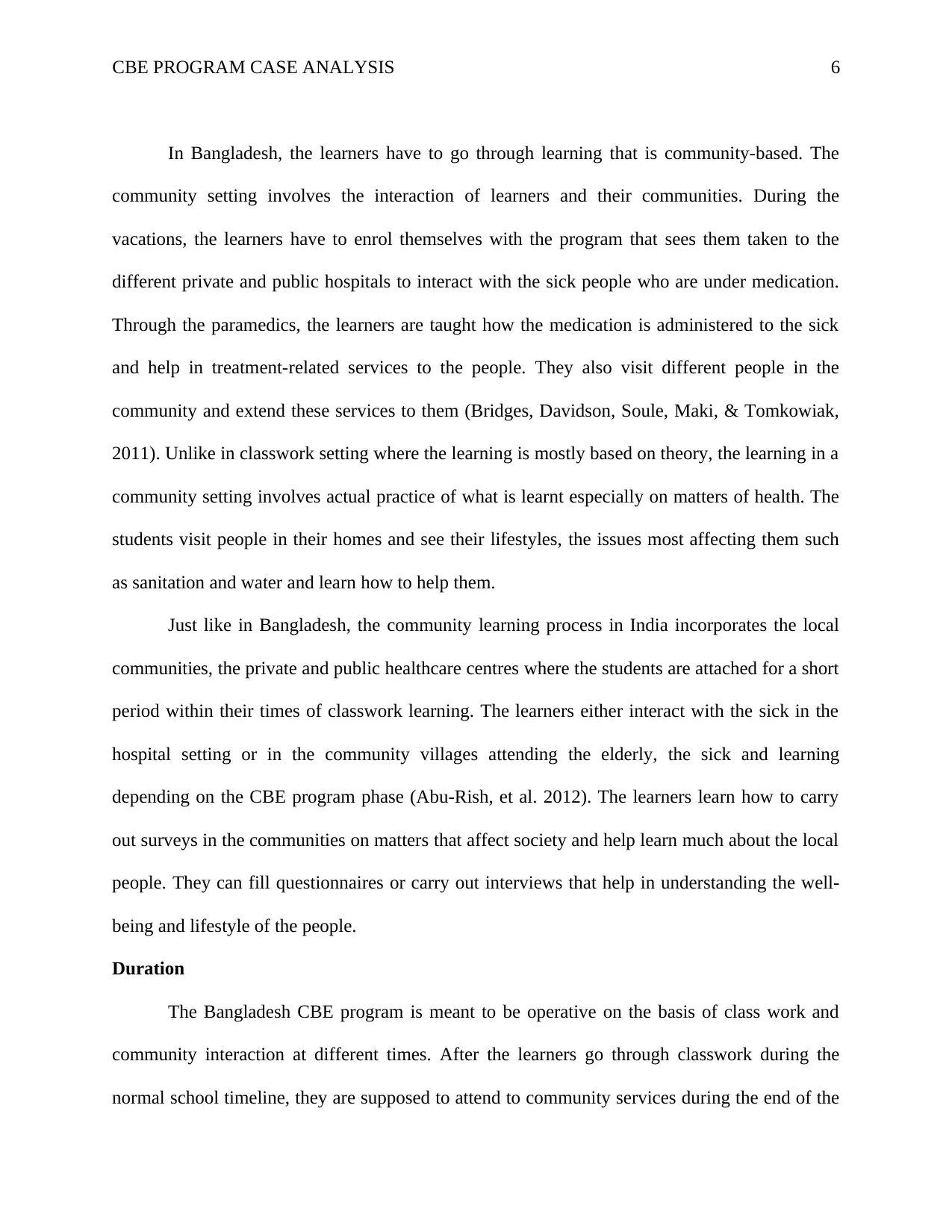
CBE PROGRAM CASE ANALYSIS 6
In Bangladesh, the learners have to go through learning that is community-based. The
community setting involves the interaction of learners and their communities. During the
vacations, the learners have to enrol themselves with the program that sees them taken to the
different private and public hospitals to interact with the sick people who are under medication.
Through the paramedics, the learners are taught how the medication is administered to the sick
and help in treatment-related services to the people. They also visit different people in the
community and extend these services to them (Bridges, Davidson, Soule, Maki, & Tomkowiak,
2011). Unlike in classwork setting where the learning is mostly based on theory, the learning in a
community setting involves actual practice of what is learnt especially on matters of health. The
students visit people in their homes and see their lifestyles, the issues most affecting them such
as sanitation and water and learn how to help them.
Just like in Bangladesh, the community learning process in India incorporates the local
communities, the private and public healthcare centres where the students are attached for a short
period within their times of classwork learning. The learners either interact with the sick in the
hospital setting or in the community villages attending the elderly, the sick and learning
depending on the CBE program phase (Abu-Rish, et al. 2012). The learners learn how to carry
out surveys in the communities on matters that affect society and help learn much about the local
people. They can fill questionnaires or carry out interviews that help in understanding the well-
being and lifestyle of the people.
Duration
The Bangladesh CBE program is meant to be operative on the basis of class work and
community interaction at different times. After the learners go through classwork during the
normal school timeline, they are supposed to attend to community services during the end of the
In Bangladesh, the learners have to go through learning that is community-based. The
community setting involves the interaction of learners and their communities. During the
vacations, the learners have to enrol themselves with the program that sees them taken to the
different private and public hospitals to interact with the sick people who are under medication.
Through the paramedics, the learners are taught how the medication is administered to the sick
and help in treatment-related services to the people. They also visit different people in the
community and extend these services to them (Bridges, Davidson, Soule, Maki, & Tomkowiak,
2011). Unlike in classwork setting where the learning is mostly based on theory, the learning in a
community setting involves actual practice of what is learnt especially on matters of health. The
students visit people in their homes and see their lifestyles, the issues most affecting them such
as sanitation and water and learn how to help them.
Just like in Bangladesh, the community learning process in India incorporates the local
communities, the private and public healthcare centres where the students are attached for a short
period within their times of classwork learning. The learners either interact with the sick in the
hospital setting or in the community villages attending the elderly, the sick and learning
depending on the CBE program phase (Abu-Rish, et al. 2012). The learners learn how to carry
out surveys in the communities on matters that affect society and help learn much about the local
people. They can fill questionnaires or carry out interviews that help in understanding the well-
being and lifestyle of the people.
Duration
The Bangladesh CBE program is meant to be operative on the basis of class work and
community interaction at different times. After the learners go through classwork during the
normal school timeline, they are supposed to attend to community services during the end of the
⊘ This is a preview!⊘
Do you want full access?
Subscribe today to unlock all pages.

Trusted by 1+ million students worldwide
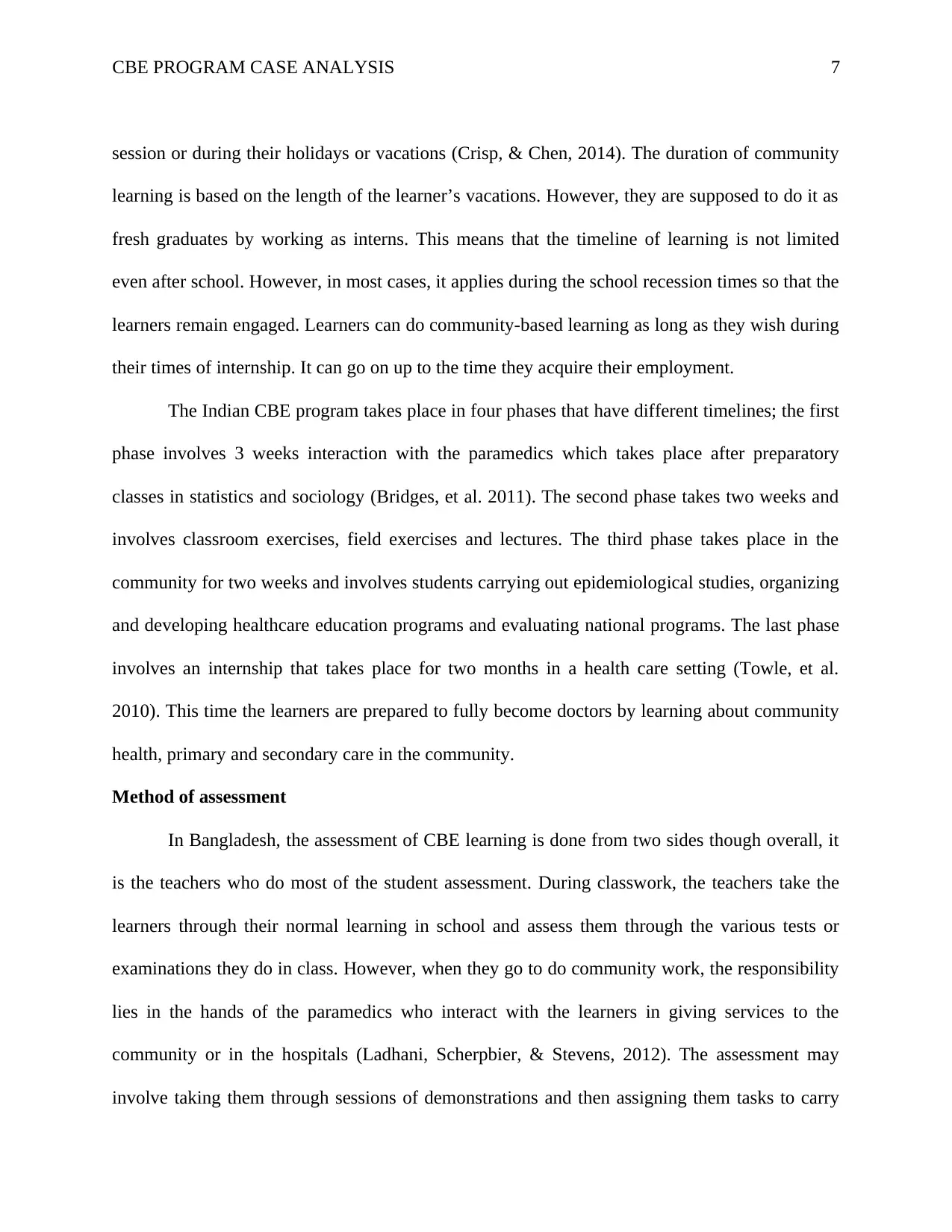
CBE PROGRAM CASE ANALYSIS 7
session or during their holidays or vacations (Crisp, & Chen, 2014). The duration of community
learning is based on the length of the learner’s vacations. However, they are supposed to do it as
fresh graduates by working as interns. This means that the timeline of learning is not limited
even after school. However, in most cases, it applies during the school recession times so that the
learners remain engaged. Learners can do community-based learning as long as they wish during
their times of internship. It can go on up to the time they acquire their employment.
The Indian CBE program takes place in four phases that have different timelines; the first
phase involves 3 weeks interaction with the paramedics which takes place after preparatory
classes in statistics and sociology (Bridges, et al. 2011). The second phase takes two weeks and
involves classroom exercises, field exercises and lectures. The third phase takes place in the
community for two weeks and involves students carrying out epidemiological studies, organizing
and developing healthcare education programs and evaluating national programs. The last phase
involves an internship that takes place for two months in a health care setting (Towle, et al.
2010). This time the learners are prepared to fully become doctors by learning about community
health, primary and secondary care in the community.
Method of assessment
In Bangladesh, the assessment of CBE learning is done from two sides though overall, it
is the teachers who do most of the student assessment. During classwork, the teachers take the
learners through their normal learning in school and assess them through the various tests or
examinations they do in class. However, when they go to do community work, the responsibility
lies in the hands of the paramedics who interact with the learners in giving services to the
community or in the hospitals (Ladhani, Scherpbier, & Stevens, 2012). The assessment may
involve taking them through sessions of demonstrations and then assigning them tasks to carry
session or during their holidays or vacations (Crisp, & Chen, 2014). The duration of community
learning is based on the length of the learner’s vacations. However, they are supposed to do it as
fresh graduates by working as interns. This means that the timeline of learning is not limited
even after school. However, in most cases, it applies during the school recession times so that the
learners remain engaged. Learners can do community-based learning as long as they wish during
their times of internship. It can go on up to the time they acquire their employment.
The Indian CBE program takes place in four phases that have different timelines; the first
phase involves 3 weeks interaction with the paramedics which takes place after preparatory
classes in statistics and sociology (Bridges, et al. 2011). The second phase takes two weeks and
involves classroom exercises, field exercises and lectures. The third phase takes place in the
community for two weeks and involves students carrying out epidemiological studies, organizing
and developing healthcare education programs and evaluating national programs. The last phase
involves an internship that takes place for two months in a health care setting (Towle, et al.
2010). This time the learners are prepared to fully become doctors by learning about community
health, primary and secondary care in the community.
Method of assessment
In Bangladesh, the assessment of CBE learning is done from two sides though overall, it
is the teachers who do most of the student assessment. During classwork, the teachers take the
learners through their normal learning in school and assess them through the various tests or
examinations they do in class. However, when they go to do community work, the responsibility
lies in the hands of the paramedics who interact with the learners in giving services to the
community or in the hospitals (Ladhani, Scherpbier, & Stevens, 2012). The assessment may
involve taking them through sessions of demonstrations and then assigning them tasks to carry
Paraphrase This Document
Need a fresh take? Get an instant paraphrase of this document with our AI Paraphraser
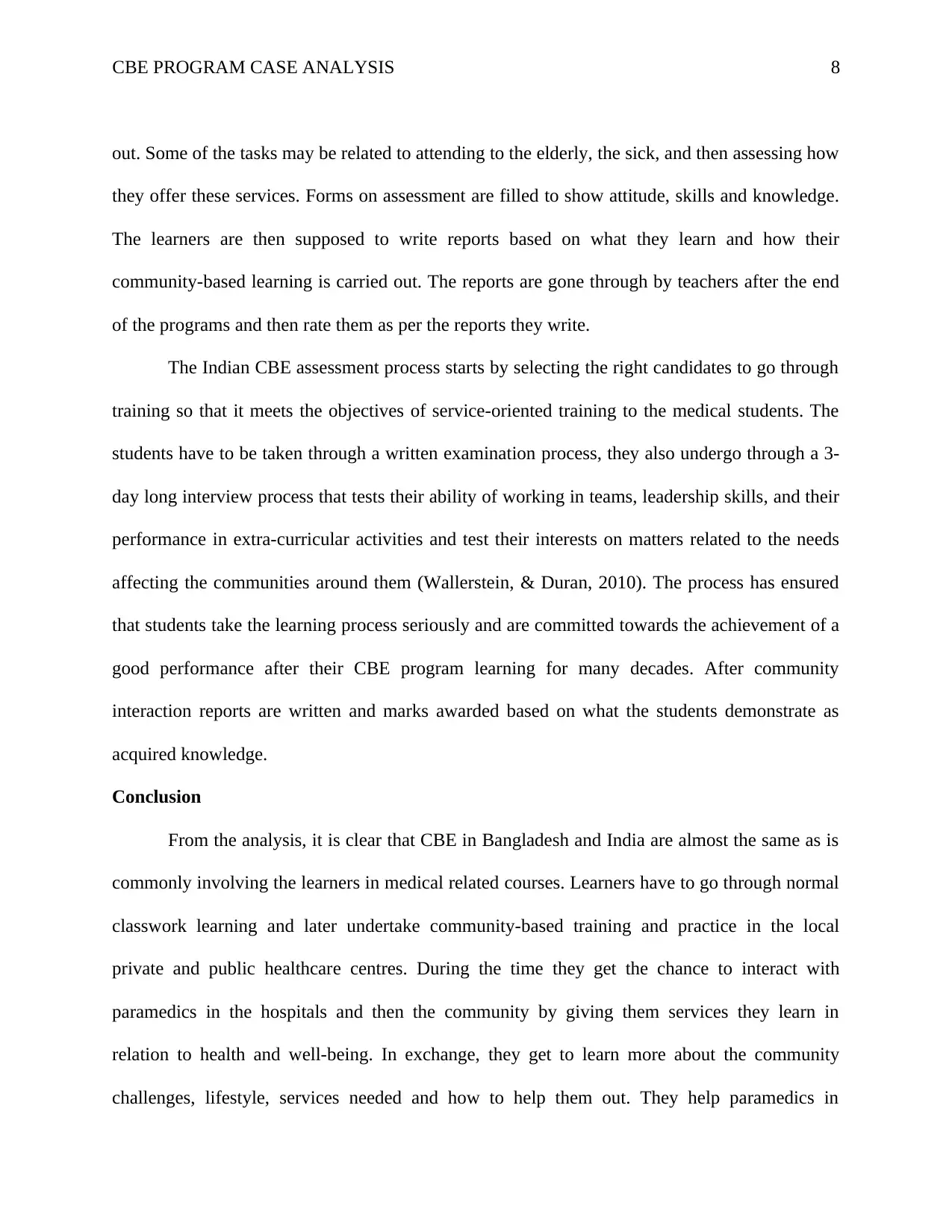
CBE PROGRAM CASE ANALYSIS 8
out. Some of the tasks may be related to attending to the elderly, the sick, and then assessing how
they offer these services. Forms on assessment are filled to show attitude, skills and knowledge.
The learners are then supposed to write reports based on what they learn and how their
community-based learning is carried out. The reports are gone through by teachers after the end
of the programs and then rate them as per the reports they write.
The Indian CBE assessment process starts by selecting the right candidates to go through
training so that it meets the objectives of service-oriented training to the medical students. The
students have to be taken through a written examination process, they also undergo through a 3-
day long interview process that tests their ability of working in teams, leadership skills, and their
performance in extra-curricular activities and test their interests on matters related to the needs
affecting the communities around them (Wallerstein, & Duran, 2010). The process has ensured
that students take the learning process seriously and are committed towards the achievement of a
good performance after their CBE program learning for many decades. After community
interaction reports are written and marks awarded based on what the students demonstrate as
acquired knowledge.
Conclusion
From the analysis, it is clear that CBE in Bangladesh and India are almost the same as is
commonly involving the learners in medical related courses. Learners have to go through normal
classwork learning and later undertake community-based training and practice in the local
private and public healthcare centres. During the time they get the chance to interact with
paramedics in the hospitals and then the community by giving them services they learn in
relation to health and well-being. In exchange, they get to learn more about the community
challenges, lifestyle, services needed and how to help them out. They help paramedics in
out. Some of the tasks may be related to attending to the elderly, the sick, and then assessing how
they offer these services. Forms on assessment are filled to show attitude, skills and knowledge.
The learners are then supposed to write reports based on what they learn and how their
community-based learning is carried out. The reports are gone through by teachers after the end
of the programs and then rate them as per the reports they write.
The Indian CBE assessment process starts by selecting the right candidates to go through
training so that it meets the objectives of service-oriented training to the medical students. The
students have to be taken through a written examination process, they also undergo through a 3-
day long interview process that tests their ability of working in teams, leadership skills, and their
performance in extra-curricular activities and test their interests on matters related to the needs
affecting the communities around them (Wallerstein, & Duran, 2010). The process has ensured
that students take the learning process seriously and are committed towards the achievement of a
good performance after their CBE program learning for many decades. After community
interaction reports are written and marks awarded based on what the students demonstrate as
acquired knowledge.
Conclusion
From the analysis, it is clear that CBE in Bangladesh and India are almost the same as is
commonly involving the learners in medical related courses. Learners have to go through normal
classwork learning and later undertake community-based training and practice in the local
private and public healthcare centres. During the time they get the chance to interact with
paramedics in the hospitals and then the community by giving them services they learn in
relation to health and well-being. In exchange, they get to learn more about the community
challenges, lifestyle, services needed and how to help them out. They help paramedics in
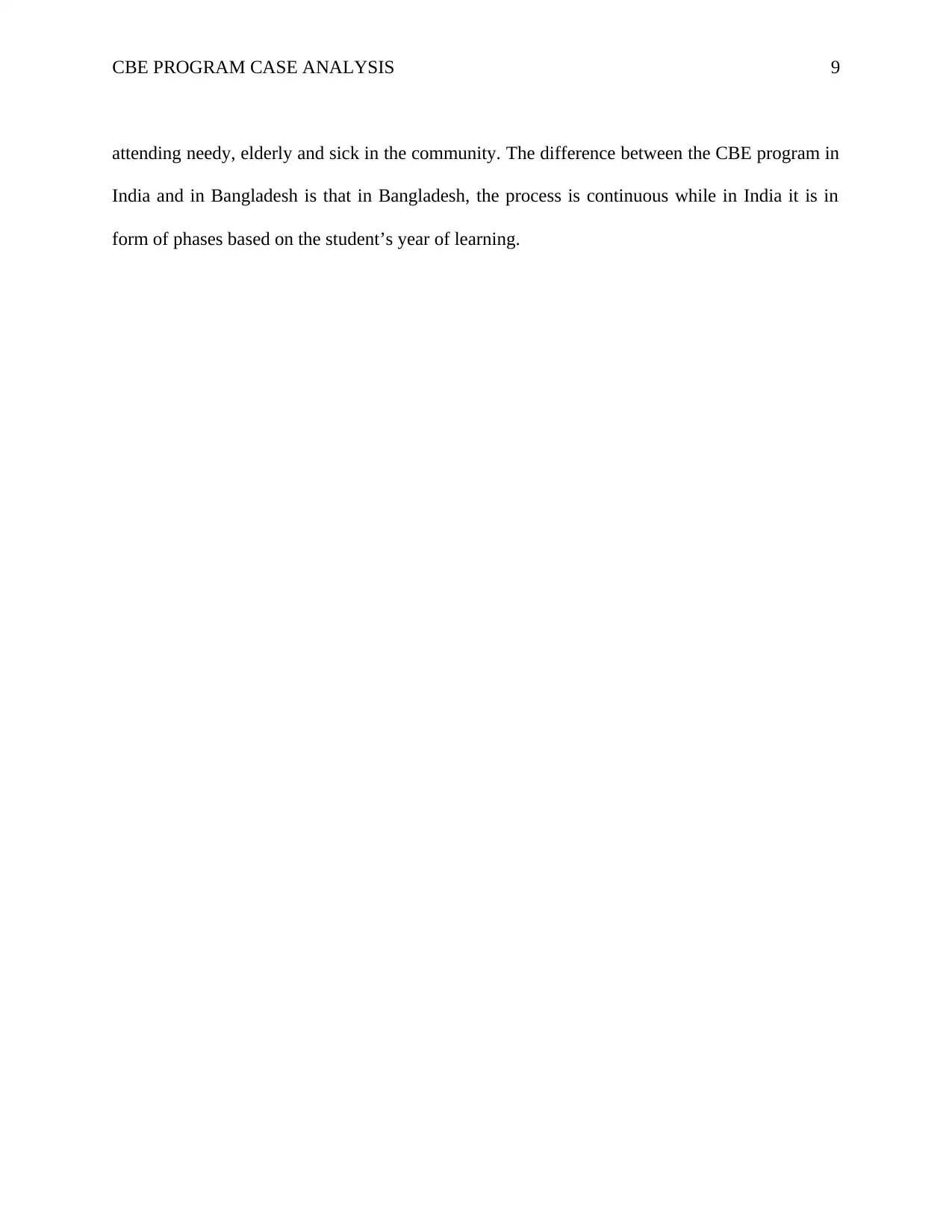
CBE PROGRAM CASE ANALYSIS 9
attending needy, elderly and sick in the community. The difference between the CBE program in
India and in Bangladesh is that in Bangladesh, the process is continuous while in India it is in
form of phases based on the student’s year of learning.
attending needy, elderly and sick in the community. The difference between the CBE program in
India and in Bangladesh is that in Bangladesh, the process is continuous while in India it is in
form of phases based on the student’s year of learning.
⊘ This is a preview!⊘
Do you want full access?
Subscribe today to unlock all pages.

Trusted by 1+ million students worldwide
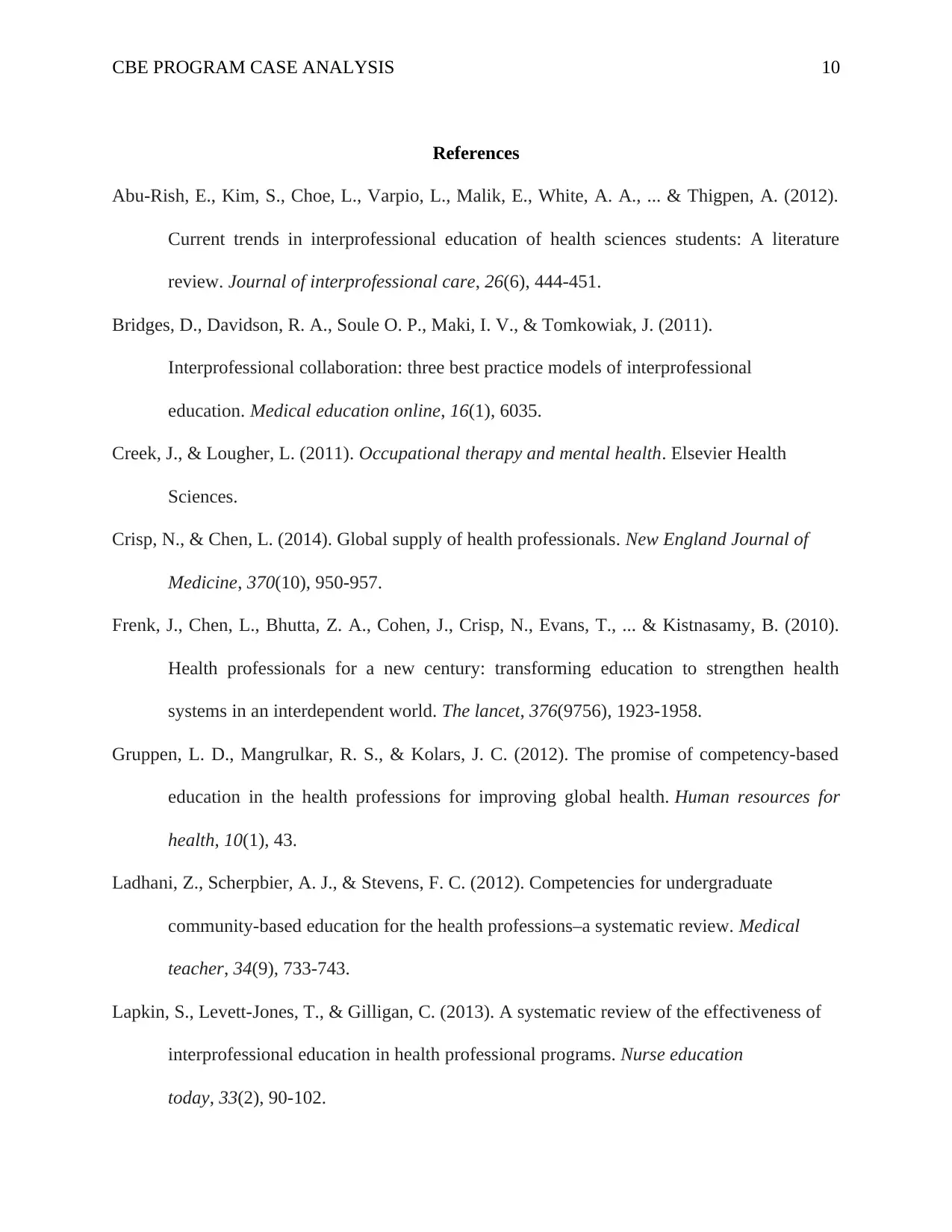
CBE PROGRAM CASE ANALYSIS 10
References
Abu-Rish, E., Kim, S., Choe, L., Varpio, L., Malik, E., White, A. A., ... & Thigpen, A. (2012).
Current trends in interprofessional education of health sciences students: A literature
review. Journal of interprofessional care, 26(6), 444-451.
Bridges, D., Davidson, R. A., Soule O. P., Maki, I. V., & Tomkowiak, J. (2011).
Interprofessional collaboration: three best practice models of interprofessional
education. Medical education online, 16(1), 6035.
Creek, J., & Lougher, L. (2011). Occupational therapy and mental health. Elsevier Health
Sciences.
Crisp, N., & Chen, L. (2014). Global supply of health professionals. New England Journal of
Medicine, 370(10), 950-957.
Frenk, J., Chen, L., Bhutta, Z. A., Cohen, J., Crisp, N., Evans, T., ... & Kistnasamy, B. (2010).
Health professionals for a new century: transforming education to strengthen health
systems in an interdependent world. The lancet, 376(9756), 1923-1958.
Gruppen, L. D., Mangrulkar, R. S., & Kolars, J. C. (2012). The promise of competency-based
education in the health professions for improving global health. Human resources for
health, 10(1), 43.
Ladhani, Z., Scherpbier, A. J., & Stevens, F. C. (2012). Competencies for undergraduate
community-based education for the health professions–a systematic review. Medical
teacher, 34(9), 733-743.
Lapkin, S., Levett-Jones, T., & Gilligan, C. (2013). A systematic review of the effectiveness of
interprofessional education in health professional programs. Nurse education
today, 33(2), 90-102.
References
Abu-Rish, E., Kim, S., Choe, L., Varpio, L., Malik, E., White, A. A., ... & Thigpen, A. (2012).
Current trends in interprofessional education of health sciences students: A literature
review. Journal of interprofessional care, 26(6), 444-451.
Bridges, D., Davidson, R. A., Soule O. P., Maki, I. V., & Tomkowiak, J. (2011).
Interprofessional collaboration: three best practice models of interprofessional
education. Medical education online, 16(1), 6035.
Creek, J., & Lougher, L. (2011). Occupational therapy and mental health. Elsevier Health
Sciences.
Crisp, N., & Chen, L. (2014). Global supply of health professionals. New England Journal of
Medicine, 370(10), 950-957.
Frenk, J., Chen, L., Bhutta, Z. A., Cohen, J., Crisp, N., Evans, T., ... & Kistnasamy, B. (2010).
Health professionals for a new century: transforming education to strengthen health
systems in an interdependent world. The lancet, 376(9756), 1923-1958.
Gruppen, L. D., Mangrulkar, R. S., & Kolars, J. C. (2012). The promise of competency-based
education in the health professions for improving global health. Human resources for
health, 10(1), 43.
Ladhani, Z., Scherpbier, A. J., & Stevens, F. C. (2012). Competencies for undergraduate
community-based education for the health professions–a systematic review. Medical
teacher, 34(9), 733-743.
Lapkin, S., Levett-Jones, T., & Gilligan, C. (2013). A systematic review of the effectiveness of
interprofessional education in health professional programs. Nurse education
today, 33(2), 90-102.
Paraphrase This Document
Need a fresh take? Get an instant paraphrase of this document with our AI Paraphraser
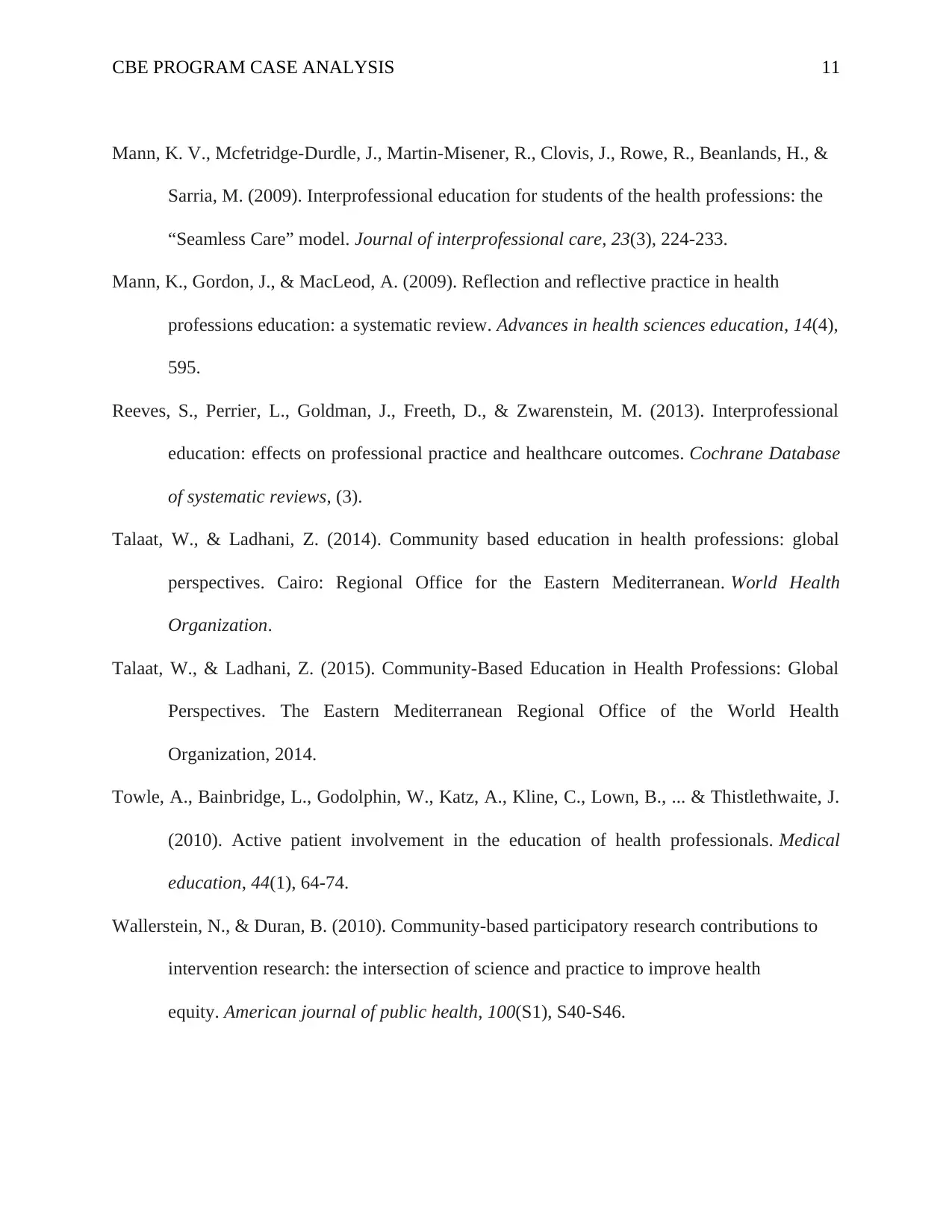
CBE PROGRAM CASE ANALYSIS 11
Mann, K. V., Mcfetridge-Durdle, J., Martin-Misener, R., Clovis, J., Rowe, R., Beanlands, H., &
Sarria, M. (2009). Interprofessional education for students of the health professions: the
“Seamless Care” model. Journal of interprofessional care, 23(3), 224-233.
Mann, K., Gordon, J., & MacLeod, A. (2009). Reflection and reflective practice in health
professions education: a systematic review. Advances in health sciences education, 14(4),
595.
Reeves, S., Perrier, L., Goldman, J., Freeth, D., & Zwarenstein, M. (2013). Interprofessional
education: effects on professional practice and healthcare outcomes. Cochrane Database
of systematic reviews, (3).
Talaat, W., & Ladhani, Z. (2014). Community based education in health professions: global
perspectives. Cairo: Regional Office for the Eastern Mediterranean. World Health
Organization.
Talaat, W., & Ladhani, Z. (2015). Community-Based Education in Health Professions: Global
Perspectives. The Eastern Mediterranean Regional Office of the World Health
Organization, 2014.
Towle, A., Bainbridge, L., Godolphin, W., Katz, A., Kline, C., Lown, B., ... & Thistlethwaite, J.
(2010). Active patient involvement in the education of health professionals. Medical
education, 44(1), 64-74.
Wallerstein, N., & Duran, B. (2010). Community-based participatory research contributions to
intervention research: the intersection of science and practice to improve health
equity. American journal of public health, 100(S1), S40-S46.
Mann, K. V., Mcfetridge-Durdle, J., Martin-Misener, R., Clovis, J., Rowe, R., Beanlands, H., &
Sarria, M. (2009). Interprofessional education for students of the health professions: the
“Seamless Care” model. Journal of interprofessional care, 23(3), 224-233.
Mann, K., Gordon, J., & MacLeod, A. (2009). Reflection and reflective practice in health
professions education: a systematic review. Advances in health sciences education, 14(4),
595.
Reeves, S., Perrier, L., Goldman, J., Freeth, D., & Zwarenstein, M. (2013). Interprofessional
education: effects on professional practice and healthcare outcomes. Cochrane Database
of systematic reviews, (3).
Talaat, W., & Ladhani, Z. (2014). Community based education in health professions: global
perspectives. Cairo: Regional Office for the Eastern Mediterranean. World Health
Organization.
Talaat, W., & Ladhani, Z. (2015). Community-Based Education in Health Professions: Global
Perspectives. The Eastern Mediterranean Regional Office of the World Health
Organization, 2014.
Towle, A., Bainbridge, L., Godolphin, W., Katz, A., Kline, C., Lown, B., ... & Thistlethwaite, J.
(2010). Active patient involvement in the education of health professionals. Medical
education, 44(1), 64-74.
Wallerstein, N., & Duran, B. (2010). Community-based participatory research contributions to
intervention research: the intersection of science and practice to improve health
equity. American journal of public health, 100(S1), S40-S46.
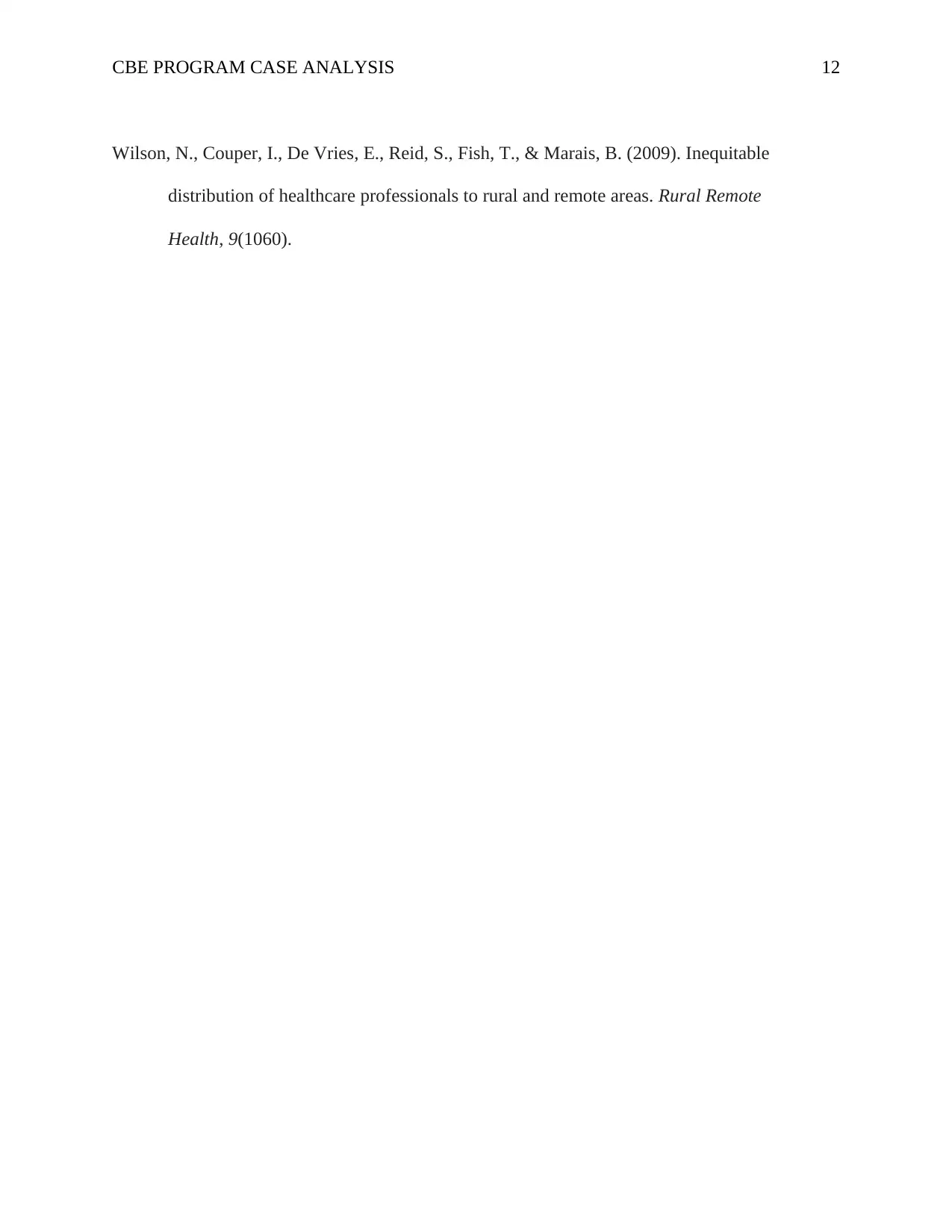
CBE PROGRAM CASE ANALYSIS 12
Wilson, N., Couper, I., De Vries, E., Reid, S., Fish, T., & Marais, B. (2009). Inequitable
distribution of healthcare professionals to rural and remote areas. Rural Remote
Health, 9(1060).
Wilson, N., Couper, I., De Vries, E., Reid, S., Fish, T., & Marais, B. (2009). Inequitable
distribution of healthcare professionals to rural and remote areas. Rural Remote
Health, 9(1060).
⊘ This is a preview!⊘
Do you want full access?
Subscribe today to unlock all pages.

Trusted by 1+ million students worldwide
1 out of 12
Related Documents
Your All-in-One AI-Powered Toolkit for Academic Success.
+13062052269
info@desklib.com
Available 24*7 on WhatsApp / Email
![[object Object]](/_next/static/media/star-bottom.7253800d.svg)
Unlock your academic potential
Copyright © 2020–2025 A2Z Services. All Rights Reserved. Developed and managed by ZUCOL.




